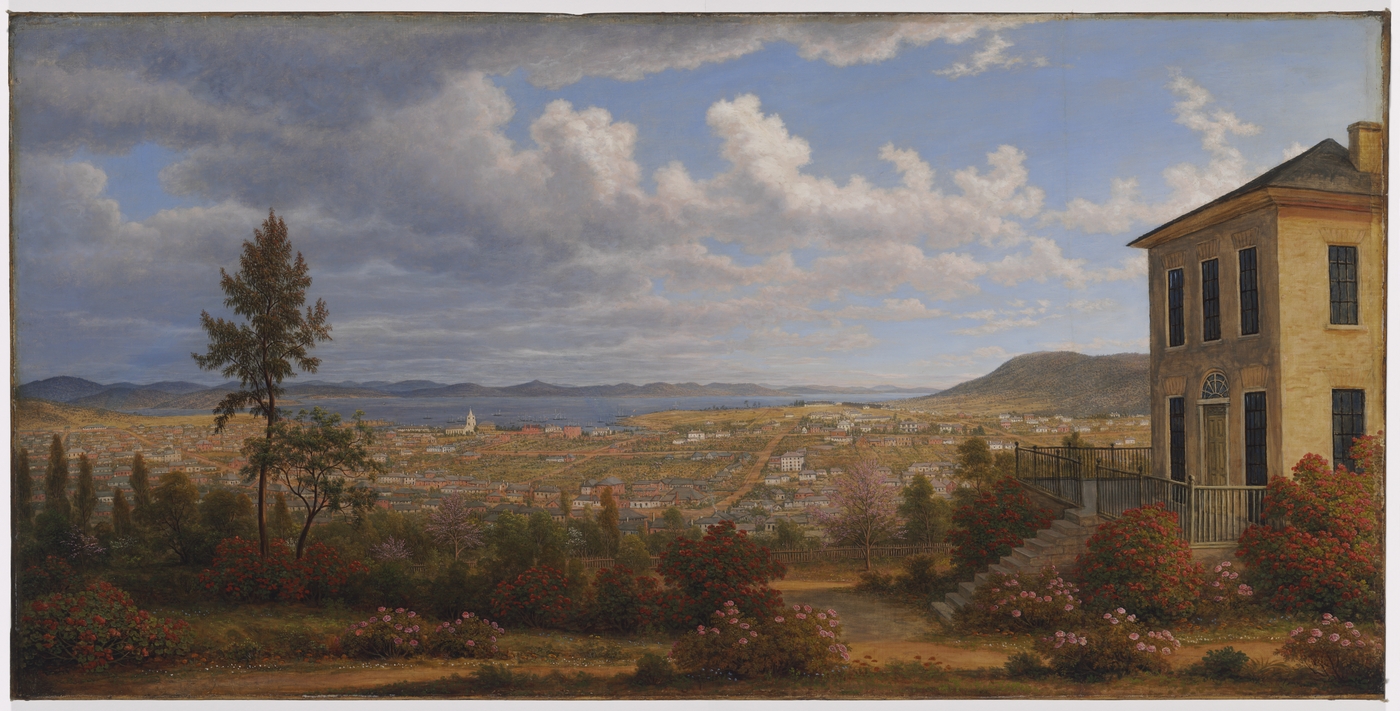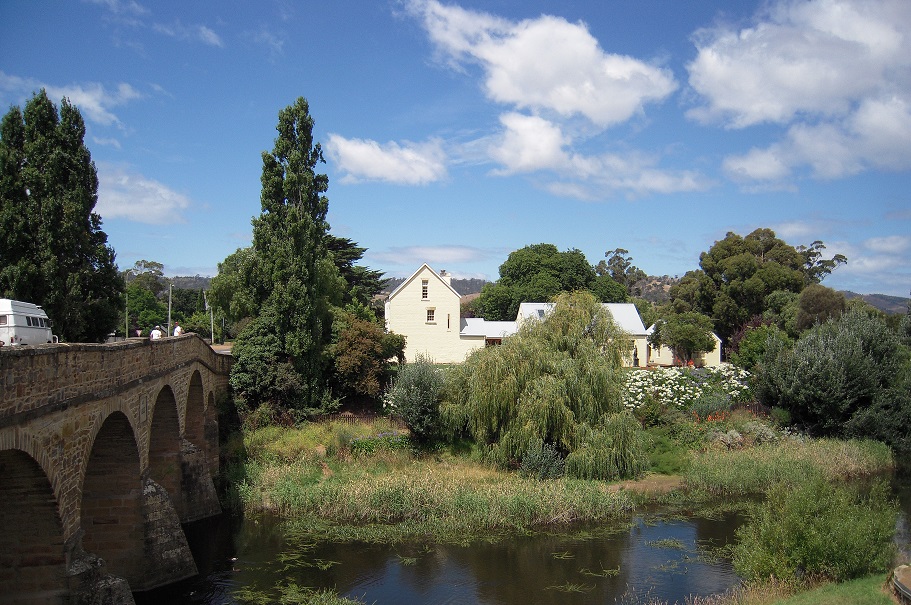AustLit
-
When Mark Twain wrote about visiting Tasmania in his travelogue Following the Equator (1897) he noted that it was in Hobart that ‘we struck the head of the procession of Junior Englands’ (281). For Twain, English beauty of landscape is made up of ‘very simple details – just grass, and trees, and shrubs, and roads, and hedges, and gardens, and houses, and vines, and churches, and castles, and here and there a ruin – and over it all a mellow dream-haze of history. But its beauty is incomparable, and all its own.’ It was Hobart that reminded Twain of this English beauty:
...it is the neatest town that the sun shines on; and I incline to believe that is also the cleanest. However that may be, its supremacy in neatness is not to be questioned. There cannot be another town in the world that has no shabby exteriors; no rickety gates and fences, no neglected houses crumbling to ruin, no crazy and unsightly sheds, no weed-grown front-yards of the poor, no back-yards littered with tin cans and old boots and empty bottles, no rubbish in the gutters, no clutter on the sidewalks, no outer-borders fraying out into dirty lanes and tin-patched huts. No, in Hobart all the aspects are tidy, and all a comfort to the eye; the modestest cottage looks combed and brushed, and has its vines, its flowers, its neat fence, its neat gate, its comely cat asleep on the window ledge. (282-83)
Twain could have been writing a caption for John Glover’s painting of 1832, ‘Hobart Town, taken from the garden where I lived’ and inscribed by the painter: ‘The Geraniums, Roses etc. will give some idea how magnificent the garden may be had here.’ Glover, a very successful landscape painter in England, emigrated to Tasmania late in life, looking for a new version of England in the southern hemisphere but with different animals, trees, and natives. Glover’s paintings like ‘Hobart Town,’ ‘Patterdale Farm’ (c. 1840) and ‘My Harvest Home’ (1835) have been very influential in creating the iconography of Tasmania as a Little England. In 1835 Glover sent sixty-eight paintings of Tasmania to London to be exhibited, and these were reviewed favourably in the Times because of their Englishing of Tasmania: '[Tasmania] bears a resemblance of the views on the lakes of Cumberland, with the exception that the hills are more lofty, possess more of a primeval aspect’ (Horne 42). Similarly, Thomas Wood in Cobbers (London: Oxford UP, 1934): ‘Hobart, the capital, has the air of an English country town which has shed its old houses and wandered down to the sea for a rest’ (162).
-
John Betjeman’s childhood memory of Tasmania was that it was advertised in England as the ‘Heart-shaped Island of Allure,’ and in his encounters with Tasmania, first in 1961 when he took a light plane up to pre-flooded Lake Pedder, landing on the beach, and later in 1971 when he made a Tasmanian episode for a television series about Australia, he delights in resemblances to Cornwall in Zeehan and the Tasman Peninsula (Payton 133). He also recognizes a ‘new kind of Gothic’ in the church architecture of Alec North, which included ‘gum-nuts and ring-tailed possums’ (‘Betjeman in Australia’).
This version of the Tasmanian landscape has its first expression in Lt. John Bowen’s small settlement at Risdon Cove, on the eastern shore of the Derwent, in September, 1803. Bowen, reporting back to Governor King in Sydney soon after his arrival, wrote that ‘[t]he Banks [of the Derwent] are more like a Nobleman’s Park in England than an uncultivated Country; every part is beautifully Green and very little trouble might clear every Valley I have seen in a Month’ (20 Sept, 1803; Historical Records of Australia, Series III, Vol 1, 1921, pp. 197-98). It was a theme reiterated by Anthony Trollope when he visited Tasmania as part of his year-long travels throughout Australia in 1871-72. Trollope’s letters from Australia were published in the London Daily Telegraph and as a volume, Australia and New Zealand, in 1873. Trollope wrote:
[It] is acknowledged even by all the rival colonies that of all the colonies Tasmania is the prettiest. This is no doubt true of her as a whole, though the scenery of the Hawkesbury in New South Wales is, I think, finer than anything in Tasmania. But it maybe said of the small island that, go where you will, the landscape that meets the eye is pleasing, whereas the reverse of this is certainly the rule on the Australian continent. And the climate of Tasmania is by far pleasanter than that of any part of the mainland. There are, one may almost say, no mosquitoes. Other pernicious animals certainly do abound, – but then they abound also in England. Everything in Tasmania is more English than is England herself. She is full of English fruits, which grow certainly more plentifully and, as regards some, with greater excellence than they do in England. Tasmanian cherries beat those of Kent, — or, as I believe, of all the world and have become so common that it is often not worth the owner's while to pull them. Strawberries, raspberries, gooseberries, plums, and apples, are in almost equal abundance [...] The Tasmanians in their loyalty are almost English mad [..] there is with them all a love of home – which word always means England, – that touches the heart of him who comes to them from the old country. (vol 2, ch. 3, p. 37-38)
This is the Tasmania that Frank Hurley re-creates in his film Isle of Many Waters, with its fox-hunters, Huon Valley apple trees and Romantic ruins at Port Arthur. Tasmania as a Little England is also the paradigm for Kathleen Graves’s account of genteel pioneering and landscape design in Midlands Tasmania, in Tasmanian Pastoral, which includes a chapter about the Midland Hunt where wombats are converted into badgers. The persistence of the Little England trope is also evident in touristic and immigration discourse that advertised Tasmania as the ‘sanatorium of the south’ and in twentieth-century Tasmanian fiction, with some contemporary adjustments, for example, in Isabel Dick’s popular fiction (Huon Belle [1930], Wild Orchard [1945]) and in Nan Chauncy’s small farm Tasmania (in They Found a Cave, Tiger in the Bush, and Tangara) (Haynes 31).
-
https://www.youtube.com/embed/0ehcpe18th4?rel=0
-
At the beginning of Patrick White’s novel A Fringe of Leaves (1976) when the Roxburghs arrive in Hobart in 1835, the husband and wife seem to embody a gendered ambivalence about the island. Austin takes a gothic view: Van Diemen’s Land is ‘a hard and morally infected country’ (82), while, for his wife Ellen, in ‘Van Diemen’s Land, almost every landscape is a watercolour’ (141), Vivian Smith’s ‘Water colour country’ (‘Tasmania,’ Effects of Light 89). Ellen’s Hobart, in White’s free indirect style, is a slightly more earthy reprise of Twain:
Mrs Roxburgh was able to enjoy her view of the unassuming, while often charming houses, their general effect of modest substance sometimes spoilt by the intrusion of an over-opulent façade. Hens were allowed the freedom of the streets, and an ambling cow almost grazed a wheel of the buggy with her ribs. The scent of the cow’s breath, the thudding of her hooves, and the plop of falling dung, filled Ellen with an immeasurable homesickness. Had it not been for the uncommunicative stares of respectable burgesses and the open scowls of those who must be their slaves, she might have been driving Gluyas’s cart to market. (83)
In the opening chapters of Christopher Koch’s Highways to a War (1995) – gothically subtitled ‘Volume One of Beware of the Past’ – the setting of the narrator’s reminiscence of his youth, with the novel’s hero Mike Langford, before escape from the island, is the Derwent Valley:
Here were the upright golden flames of the poplars lining the road, and the willows yellowing down by the creek. Here were the hop fields, and elms and pines and cedars: the country of early settlement, rich and Europeanized […] The English oak trees in the drive were always out in leaf, and powdered with the road’s white dust, like the roadside poplars. (21)
This writing is a close relative of Michael Sharland's Romantic heritage in Stones of a Century and Oddities and Elegance. Although Koch well recognises the lack of depth, the façade, the ‘duplication’ of this version of Tasmania:
It began, of course, as a seabound jail, where the pickpockets from the rookeries of St Giles and Cambden Town were dumped; but it was also another Kent, another Dorset, another Cumberland [Koch is citing names for early counties of Van Diemen’s Land] for the free settlers. At the same time, it was on the extreme rim of the world, one of the remotest places on earth. And it’s always fascinated me to picture this perfect recreation of the lost home going on at the edges of Antarctic nothingness. Very soon the stage sets and the giant mirrors were complete: among gentle hills and green pastures that made it all perfectly natural, the great-grandfathers (my own among them) had freestone cottages with mullioned windows; hop fields and orchards; hawthorn hedges; climbing roses around outdoor privies; brutal boarding schools; Cockney sparrows to perch on slate roofs; rabbits to eat the crops; churches, brothels, and a thieves’ kitchen by the Hobart docks called Wapping Old Stairs. In the midlands, the gentry mulled their claret in winter and rode to hounds. (‘The Lost Hemisphere,’ Crossing the Gap: A Novelist's Essays, London: Hogarth, 1987, pp. 92-3)
A very similar version of this Tasmania appears in chapter 2 of The Doubleman (1985) and once again the lived illusion of Little England is underlined, this time in terms of the myth of Plato’s cinematic Cave, in terms of culture, rather than landscape: ‘we must study shadows on the wall: Bitter Sweet at the Hobart Repertory; Kind Hearts and Coronets at the Avalon Cinema; the novels of A.J. Cronin and J.B. Priestley and Graham Greene; shadows, all shadows, clues to the other hemisphere we might someday discover’ (24). Koch might also have mentioned, given the romantic depictions of Hobart’s north scattered throughout his fiction, the partially realised model English Garden Cities for industrial workers at Lutana and Bourneville (see ‘Shelter,’ Companion to Tasmanian History). Sharon Morgan’s Land Settlement in Early Tasmania: Creating an Antipodean England (Cambridge UP, 1992) is an historical account, up until 1830, of the role of land alienation, pastoral company history and farming practice in the Anglicising of the land of Van Diemen’s Land.
-
Read on to the next section: Tasmanian Gothic and its discontents.
You might be interested in...






